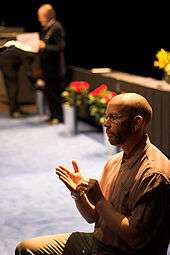Location (sign language)
In sign languages, location, or tab, refers to specific places that the hands occupy as they are used to form words. In Stokoe terminology it is known as the TAB, an abbreviation of tabula. Location is one of five components of a sign, along with handshape (DEZ), orientation (ORI), movement (SIG), and facial-body expression. Different sign languages make use of different locations.
Locations in American Sign Language

A sign language interpreter at a presentation. The location is the neutral space in front of the chest.
American Sign Language uses 12 locations excluding the hands themselves, concentrated around the face: the whole face/head; the forehead or brow; the eyes or nose; the mouth or chin; the temple, cheek or ear (side of the head); the neck; the trunk (shoulders to waist); the upper arm; the elbow or forearm, the back of the wrist, and the inside of the wrist. In addition, a passive hand may serve as the location of the sign, in which case it may take any of several handshapes; these handshapes (fist, flat hand, etc.) are also considered to be locations (tabs). A sign may also be made in neutral space without a specific location.[1]
References
- ↑ Stokoe, Casterline, & Croneberg, 1965. A Dictionary of American Sign Language on Linguistic Principles, Gallaudet
|
|---|
|
|
|
| By region[a] | | Sign languages by region |
|---|
| Oceania | |
|---|
| Asia |
- Bengali
- Chinese
- Philippine
- Indonesia: Indonesian, Kata Kolok (Benkala, Balinese)
- India: Alipur, Bengali Indo-Pakistani, Naga
- Israel: Al-Sayyid Bedouin, Ghardaia, Israeli, Kafr Qasem, Yiddish
- Japan: Amami Oshima, Japanese
- Korean
- Malaysia: Malaysian, Penang, Selangor
- Mongolian
- Nepal: Ghandruk, Jhankot, Jumla, Nepalese
- Persian
- Saudi Arabia: Saudi
- Singapore
- Sri Lankan
- Taiwanese
- Thailand: Ban Khor, Thai
- Vietnamese
|
|---|
| Africa | |
|---|
| Europe | |
|---|
| North America |
- Plains Sign Talk
- Canada: American, Blackfoot, Cree, Ojibwa, Maritime, Quebec, Inuit, Plateau
- Mexico: Chatino, Mayan, Mexican
- United States: American (Black American), Blackfeet, Cree, Cheyenne, Ojibwa, Keresan, Martha's Vineyard, Navajo, Navajo Family, Plateau, Sandy River Valley, Henniker
|
|---|
| South America | |
|---|
| International | |
|---|
|
|---|
|
Language
families[a] | | Sign languages by family |
|---|
| | |
|---|
| |
|
|---|
| | |
|---|
| |
|
|---|
| Chinese Sign |
|
|---|
| | | | |
|
|---|
| Austro-
Hungarian |
|
|---|
| Old Belgian | |
|---|
| | |
|---|
| Dutch | |
|---|
| Italian | |
|---|
| Mexican | |
|---|
|
|---|
| | |
|---|
| | |
|---|
| |
- Bangalore-Madras Sign Language
- Beluchistan Sign Language
- Bombay Sign Language
- Calcutta Sign Language
- Delhi Sign Language
- Nepali
- North West Frontier Province Sign Language
- Punjab-Sindh Sign Language
|
|---|
| | |
|---|
| | |
|---|
| | |
|---|
| | |
|---|
| | |
|---|
| |
- Haiphong
- Hanoi
- Ho Chi Minh City
|
|---|
| | |
|---|
| | |
|---|
| Kentish |
|
|---|
| Other |
|
|---|
| Isolates | |
|---|
|
|---|
|
| ASL | |
|---|
|
Extinct
languages | |
|---|
|
| Linguistics | |
|---|
|
| Fingerspelling | |
|---|
|
| Writing | |
|---|
|
Language
contact |
|
|---|
|
| Media |
- Films (list)
- Television programmes (list)
|
|---|
|
| Persons | |
|---|
|
| Organisations | |
|---|
|
| Miscellaneous | |
|---|
|
^a Sign-language names reflect the region of origin. Natural sign languages are not related to the spoken language used in the same region. For example, French Sign Language originated in France, but is not related to French.
^b Denotes the number (if known) of languages within the family. No further information is given on these languages. |
